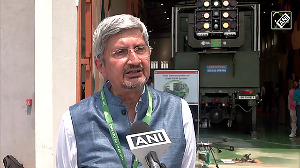'From our survey we found that there was a problem in the agricultural sector and drones could solve the problem.'

The share of agriculture in the Indian economy last year was 18.3% of GDP though agriculture employs half of India's workforce.
But India still lags behind the world in adopting new technologies in farming.
Reports say the global market for agriculture drones (used for spraying chemicals) is expected to reach $4.4 billion by 2024, with the United States having a 31.1% share of the global market share.
On the other hand, usage of drones in India's agriculture sector is expected to reach $121.43 million by 2030 as more than 50% of the market still prefer manual spraying.
Another report says drones are expected to take over $127 billion worth of human labour.
Anticipating a rapid growth in the usage of drones in the next few years, the government announced the Didi Drone Scheme which will train around 15,000 women from various self-help groups in operating and managing drones.
It is against this background that Thanos Technologies, a start-up based in Hyderabad, gains importance.
"There are approximately 670,000 villages in India, and I don't think drone manufacturers have covered even a few thousand villages so far," Pradeep Palelli, the co-founder and CEO of Thanos Technologies, tells Rediff.com's Shobha Warrier.

Before starting Thanos Technologies, you were a partner at Efficient Carbon Management Solutions, a company that was associated with environment and sustainability. Then, you were the co-founder of Zolt Energy, a rooftop solar company. Now, you are the founder of an agriculture drone manufacturing company.
How did you move from the field of environment and sustainability to drones?
After finishing my engineering from BITS, Pilani, I joined Infosys, but soon realised that software did not interest me. So, I joined Efficient Carbon as a partner, a start up in carbon management. That was the beginning of my association with the environment.
My interest was more in creating products, and as it was a consulting company, I quit after a couple of years.
After that, I along with a few friends started Zolt Energy, a start up that built roof top solar panels for homes and small commercial units.
I was the CTO of our company responsible for designing and building solar panels.
Over a period of time, I realised the field is more of operational than technology driven. The field of solar panels depended heavily on subsidies, and you were competing against some very big companies. If you are funded heavily, it is a great segment to be in. Otherwise, no.
In 2015, I decided to enter the field of drones.
Why drones?
Because at that time drones were a hot topic globally, maybe not in India. There were news items almost every day about what people were doing with drones.
I found the technology and its applications exciting. While they were being used popularly in surveying, mapping, photography, etc., small drones were already being used in China and Japan in agriculture.
In fact, in the 1990s itself, Japan was using drones for agricultural spraying. I think Yamaha was the first one to launch agricultural drones.
Unlike the advanced countries, China and India had been slow in mechanising the farm sector. But when I found that drones were widely used in the Chinese agricultural farms, I felt it could be done in India too as we have similarities in population, agricultural land size, etc.
So, you wanted to concentrate on the use of drones in agriculture alone?
Yes. I am also of the opinion that when you start a company, it is better to focus on a specific application rather than many areas.
I felt agriculture was a low hanging fruit. The sector was facing a lot of problems because of the shortage of manual labour as a lot of labour is migrating to cities for better opportunities.
We felt the time had come to automate the sector.
From our survey we found that there was a problem in the agricultural sector and drones could solve the problem.
In 2016, I founded Thanos Technologies along with Pratyush Akepati who is now the CTO of the company.
How challenging were the initial days?
It is not easy for any start-up. Every start up is a difficult game.
We started with Rs 5 lakhs and it was our own money and until recently, we were a bootstrap company.
We were only the two of us in the beginning. In the first one-and-a-half years, we worked out of a co-working space in Hyderabad.
The main problem a hardware start-up faces is funding. While it is easy for software companies to raise funds, it is not so for manufacturing companies.
As we were in the hardware domain, we had to invest in machinery, raw materials, etc. We also can't scale up like the software companies.
Yes, we had difficulties in raising funds. And manufacturing companies need funds to survive long enough to attract funding.
So, we did many things to generate revenue to survive. For example, as there were no regulations for drones in India till 2020, we made drones for defence, academic institutions, companies, etc. We also provided service to large companies.
Then, a lot of R&D was required in our project. And we had to build a prototype as fast as we could.
So, even while we were doing other things to survive, our agriculture drones were being tested by some of the world's large agro-based companies. We worked with them as a drone partner.
In 2017, the porotype of a 5-litre capacity drone was ready for demonstration at an exhibition in Vizag. The response we got was excellent.
A couple of other companies also demonstrated their drones, but they were imported. Ours was 100% made by us in India.
Though we could import parts from China and assemble, from the beginning we were focussed on designing and building our own drones so that we have the know-how to give proper service and maintain them.
In 2018, we moved to an incubation centre at IIIT-Hyderabad. We could participate in many events there which helped us immensely.
Over a period of time, we had put in Rs 1 and a half crores.
You said, it was an unregulated field till 2020....
Yes. It was only in 2020-2021 that the DGCA (Directorate General of Civil Aviation) came out with regulations for drones in the form of Drone Rules, 2021.
Now, you need to have a Remote Pilot Certificate (RTC) to operate a drone, like you need to have a driving license to drive a car. Like you need a Registration Certificate for your car, you need a license certificate for your drone.
So, every drone that is manufactured gets a certificate before it goes for sale.
This gives the investors and also the companies the confidence that this is no longer an unregulated market.
That was when the market really took off.

How aware are Indian farmers of using drones for spraying chemicals in the field?
Thanks to social media, YouTube channels, a lot of farmers have seen the videos of drones spraying chemicals in the agricultural field.
But I want to add that 95% of Indian farmers are not aware of this technology.
There are approximately 670,000 villages in India, and I don't think drone manufacturers have covered even a few thousand villages so far.
Drone usage is more in some states than the others. Our drones are mostly used in some of the villages in AP, Karnataka, Maharashtra, Tamil Nadu, Chhattisgarh and Madhya Pradesh.
So, the next 2-3 years are very crucial for the entire industry as that's when all of us would be taking this technology to every part of the country.

Is unavailability of labour the main reason why farmers may need drones?
The entire drone technology has come up due to shortage of labour. Manual labour is going down everywhere.
Farmers are finding it difficult to get manual labour and if at all they get labour, engaging them and managing them has also become difficult. If your farm is bigger, you need more labour. This is where drones come to their rescue.
But that is not the only reason why farmers may need drones.
Now, farmers are aware of the health hazards involved in manually spraying chemicals. As the person who operates a drone is not present inside the field. but outside, his exposure to the chemicals is very limited.
But the primary attraction of drones is its speed and efficiency. Where it would have taken one hour for a person to spray an acre manually, it takes just 7 to 8 minutes for the drone.
Drones are more effective also. Because this is an aerial application, the fans of the drone exert force on the plants, which helps all the parts of the plant getting exposed to the chemicals which the manual labour would have missed. So, the effectiveness of the same amount of chemicals is more if you use drones.
How big is the drone market, and how much do you expect it to grow in the next few years?
The industry estimate is that 400,000 to 500,000 drones are required for India in the next few years. But even if we take a slightly conservative figure, the market size is in the range of $3 billion to $4 billion.
It is not that every village in India needs a drone, but there are some villages where multiple drones are required too.
More than the initial number, this is a recurring market as the life span of a drone is 4 to 5 years if maintained well. In 4 to 5 years, a majority of the drone parts are either replaced or the entire drone itself is replaced.
As far as our company is concerned, chronologically we are the first entrant in the market in May 2016. So, we have the head start.
Over a period of time, there will be many more players in the field, but we expect a market share of 20% in India.
Today, 300 drones from our company are operational at various parts of the country.
We are also looking at an export market, mostly in Sri Lanka and the South East Asian countries like Vietnam, Indonesia, etc.
Then there is Africa. 5 to 6 countries in Africa are going to be a very major market. We have already started exporting to Africa.
We are confident that we can compete with some of the Chinese or European companies as we stand for quality.
Even when our exports increase, manufacturing will happen in India, in our new production unit on the outskirts of Hyderabad.
Our unit has an annual production capacity of 3,000 drones. This unit can serve the Indian market and also exports for the next 1 to 2 years. After that, we expect the demand to increase to 15,000 to 20,000 drones annually.
Our drones will be Made in India, exported to the world from our local unit.
Will the international market be your major target in future?
If we look at our short-term growth, India will remain our big market. But long term, once we conquer the African market. Our global market share will be larger than what we will have in India.
Our revenue last year was Rs 20 crore (Rs 200 million) and this year, our target is Rs 75 crores to Rs 80 crores (Rs 750 million to Rs 800 million).
In the next 3 to 5 years, we expect to be a Rs 1,000 crore (Rs 10 billion) revenue company with a good market share within India and globally too.
Feature Presentation: Ashish Narsale/Rediff.com











 © 2025
© 2025